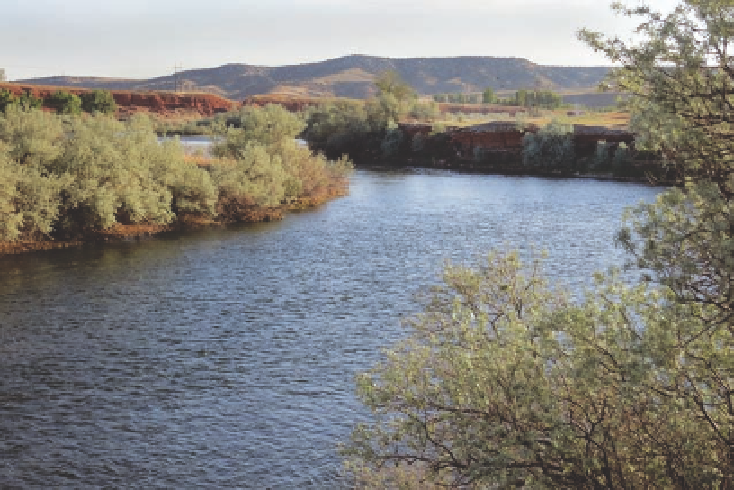Geoscience Reference
In-Depth Information
potential for salts to accumulate on the irrigated soil
surface. eventually, this salinization may reduce crop
growth. one solution is to flood the soil periodically,
but this alternative simply washes the salts into other
bodies of water. the losses of one ecosystem are the
gains of another. Also, sprinkler irrigation produces
much less return flow. Less water is applied to a field,
leaving less water that percolates into wetlands or
back to the stream. consequently, with more efficient
irrigation, water levels in all kinds of wetlands can be
lower in the fall.
39
ther. Some rivers were clogged with logs. After gold was
discovered, feverish digging began adjacent to stream
channels. About that time, herds of thirsty livestock
also trampled the shorelines, here and there, possibly in
a way that was not typical of bison herds.
thus, many riparian zones were destroyed or clearly
disrupted by the end of the nineteenth century, at a
time when numerous exotic plants had been introduced
to western states—plants that were well adapted to sur-
Some were invasive, that is, they gradually displaced
because it was thought they might be economically
or aesthetically valuable; others arrived on their own,
such as canada thistle, leafy spurge, yellow sweetclover,
Kentucky bluegrass, and smooth brome. in retrospect,
many land managers now recognize that introduced,
invasive plants—other than crops—can bring more
problems than benefits. Moreover, controlling such
plants is costly, if even possible.
two noteworthy invasive plants in the region are
Russian olive and saltcedar (tamarisk). Russian olive
was widely planted for windbreaks on the semi-arid
uplands and as an ornamental tree in towns. However,
it has invaded many riparian zones to the point that
many people think of it as
naturalized
(fig. 4.16)—the
next thing to a native
.
Unlike cottonwood, it does not
require periodic floods for the establishment of new
Invasive Plants, Climate Change, and the Future
the very first large-scale disturbance in the region by
euroAmericans, on any landscape, occurred in ripar-
ian zones, namely, commercial beaver trapping in the
early 1800s (see chapter 2). Prior to that time, disease
may have caused fluctuations in the number of beavers,
but intensive trapping greatly reduced their population
sizes throughout north America. Many beaver dams
surely failed, and in some areas new gullies formed. A
few decades later, some of the same waterways were sub-
jected to a second round of human-caused disturbances
Stream banks were cleared in many places, and sluice
dams were constructed to create flash floods that car-
ried thousands of logs, disrupting the floodplain fur-
Fig. 4.16. Russian olive, with gray-green
leaves, is an introduced invasive tree in
riparian zones at low elevations, such as
here along the Bighorn River south of
thermopolis. elevation 4,345 feet.

Search WWH ::

Custom Search